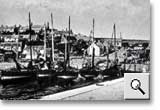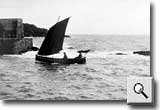|
|
|
| |
|
|
| |
Old
Slains Castle |
|
| |
| |
| Old
Slains Castle viewed from the north. On its headland
site the castle is now a ruin having been destroyed
by King James V1 of Scotland in 1594 to punish
the Earl of Erroll for the part he played in a
Catholic plot against him.
In the foreground is an upturned boat which
was used as a shed for storing fishing gear.
The hamlet was largely abandoned in 1900 when
the inhabitants, with only a very inadequate
natural harbour and following several seasons
of poor fishing, voted to move to seek their
fortunes in Aberdeen. |
|
 |
| |
|
|
| |
|
|
 |
Built from the
dark limestone rock that was quarried in Collieston
the castle is of mixed rubble and faced stone
construction. The walls are two metres thick with
some internal stairways still intact.
The single storey cottages clustered around the
keep are of rubble construction, both harled and
unrendered and with clay pan tile roofs. The village
was largely abandoned in 1900 when most of the
inhabitants, following several seasons of poor
fishing, voted to move to seek their fortunes
in Aberdeen.
|
| |
|
| |
|
|
| |
Fishing |
|
| |
| |
| The
Collieston fishing fleet of larger, tall masted,
yawls in port circa 1900. Some of the fishermen’s
gear can be seen lying on the Pier. Beyond the
yawls, the gable end of the cottage now known
as ‘Buckies’ is easily identifiable,
as is the line of the road running from the harbour
up to the village. |
| |
| In
wintertime the yawls were taken to the shelter
of the Ythan Estuary |
| |
|
 |
| |
|
|
 |
A
yawl sails into Collieston harbour at the
beginning of the 20th Century by which time
the fishing industry in Collieston was in
decline.
After the Pier was built in 1894, the harbour
began to silt up, small herring boats became
outmoded and the young men left to join larger
boats working from Torry, Aberdeen. Soon there
were not enough men left to haul the large
line boats up the beach.
By 1900 only sixteen boats were left, by
1929 only fourteen small boats, and the
few remaining
fishermen were well into middle age. Norman
Grant, who died in 1971, represented the
end
of the line as far as commercial fishing
out of Collieston was concerned.
|
|
|
|
| |
|
|
| |
Rescue
at sea |
|
| |
| |
On
16th August 1907, George Ligertwood went to the
rescue of Miss J.E.Adam who had got into some
difficulty at Hackley Bay, south of Collieston.
His bravery was recognised by the Royal Humane
Society whose patron was King Edward V11.
At a committee meeting, chaired by Colonel Horace
Montagu, and held at the Society’s Office
at 4, Trafalgar Square, London, on 15th November
of the same year, it was unanimously resolved
that George Ligertwood be duly awarded a certificate,
printed on vellum, for gallantly saving the life
of Miss Adam.
|
|
 |
|
| |
|
 |
|
| ....copyright
collieston's century 2003 |
|